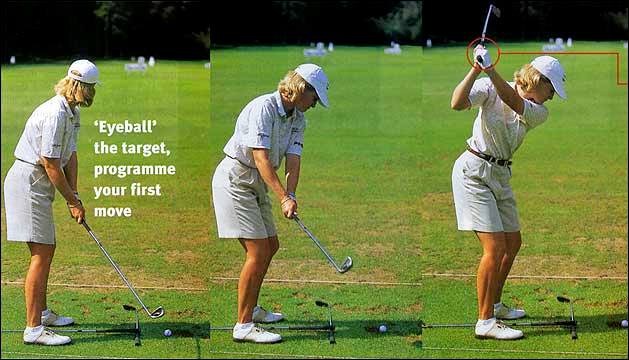Tuition
Move Over – Then Hit It
by Janice MoodyShifting your weight in harmony with the direction of your swing is essential for maintaining rhythm and creating maximum power.
A smart address
A pre-shot routine is designed to prepare both your body and your mind to make your best swing. This is something you have to work on when you practise. Thinking clearly about the shot you intend to play – specifically the details of your alignment – is part and parcel of that process.
On the range, I generally place a couple of clubs on the ground to keep my alignment in good order. The club between my feet works as a T-Square and helps me to monitor the ball position. With the mid- to short irons (here I am using a 6-iron), I like the ball to be towards the middle of my stance, moving it slightly further forward for the longer irons and woods.
But not too far forward. There’s not much deviation. And remember, the ball position relative to your stance is not measured from your toes (which are turned out) but from the inside of the heels.[octo_single_image image=”113295″ img_size=”full” alignment=”center”]
Pre-empt your move
Rehearsing the first move away from the ball (or even swinging the club all the way to the top) helps me to get a good sense of the feelings that I want to achieve with my real swing. I find that moving the club back a couple of times also helps to keep the muscles in my hands and arms – and upper body generally – relaxed, which is particularly important in terms of establishing a good rhythm.Whether you are a scratch player or a novice to the game, a positive waggle of the club head should feature in your pre-shot routine. Once you are nicely set up to the shot, rehearse your move away with a full waggle, keeping the hands and wrists supple and relaxed. Do this as you take a last look at your target.
At the same.time, try to sense that your weight is preparing to move across to your right side. I am aware of a slight ‘bump’ across to my right side as I waggle the club. This helps to guarantee that my weight does move away from the target when it’s finally time to go.[octo_single_image image=”113293″ img_size=”full” alignment=”center”]
Going nowhere…
The reverse pivot is one of the most common and destructive faults in golf. Invariably, it kills all hope you might have of creating a good back swing coil and hitting solid shots.
When your weight lingers on your left side as you reach the top of your back swing, not only do you destroy the fluency of your motion but you create a situation which, inevitably, will result in your, weight traveling away from the target as you unwind back to the ball.
In other words, if you are susceptible to a reverse pivot, your weight transfer is fighting the direction (and the logic) of your swing. The result? A weak and choppy attack on the ball, poor distance, poor accuracy.[octo_single_image image=”113294″ img_size=”full” alignment=”center”]
Turn, and get on to your right side
Don’t be afraid to move off the ball and really get behind it when you make your back swing. You simply must get across and on to your right side if you want to give yourself any chance of releasing the club head at speed through impact.Many people worry about moving the head during the swing. Don’t. Watch the best players in the world and you will notice they move their head a little to the right to facilitate a full shoulder turn and thus encourage a full wind-up.
Shifting your weight in harmony with the direction of the swing is particularly important for women when it comes to creating power. As a swing key, think about getting your left shoulder across to a position above your right knee. Achieve that, and you will be in good shape.
As the body turns, the arms swing… freely
I feel that my swing is more or less controlled by the turning (rotary) motion of my upper body. But at the same time I do like to focus on swinging my hands up high to achieve a good position at the top, the club parallel with the ball-to-target line.[octo_single_image image=”113296″ img_size=”full” alignment=”center”]In this position, my weight is supported on my right side, and from here I am aware of a great sense of ‘unwinding the spring’ as I accelerate freely into the back of the ball. The conclusion to all this is that I ‘free¬wheel’ to finish with the majority of my weight now on my left side, my body having turned completely through the shot.
The thoughts contained within this article suit my game and help me to play consistent golf. If you can spend a little time to put these ideas into action, I guarantee you will hit better and longer shots.
